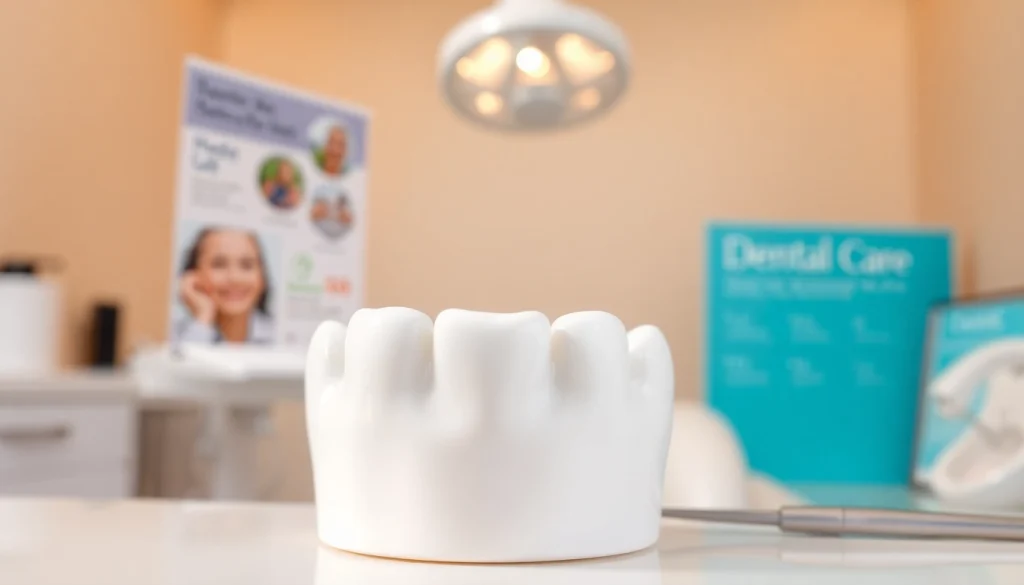
What are Dental Crowns?
Definition and Purpose
A dental crown, often referred to as a tooth crown or cap, is a custom-made covering that fits over an existing tooth or implant. It serves multiple purposes: to restore the tooth’s shape, size, strength, and appearance. Crowns are typically used when a tooth is significantly damaged or decayed, offering both functional and aesthetic benefits. For individuals seeking to enhance their dental health, understanding the role of crowns is essential.
How Crowns Function in Dental Restoration
The primary function of a dental crown is to protect a compromised tooth and restore its integrity. Made from various materials, crowns can act as a barrier against further damage caused by decay or biting forces. They can support a weak tooth, prevent tooth shifting after a filling, and improve the overall aesthetics of one’s smile. In restoration dentistry, crowns are a critical element, especially for patients with large cavities or those who’ve undergone root canal treatment.
Common Reasons for Receiving Crowns
The need for dental crowns arises due to various dental issues:
- Severe decay: When a tooth has extensive decay that a filling cannot adequately repair, a crown may be required.
- Root canal therapy: Teeth that have undergone this procedure often need crowns for protection and functional restoration.
- Broken or fractured teeth: Crowns can restore broken teeth and improve functionality.
- Cosmetic improvement: Crowns can enhance the shape or color of discolored teeth, making them more aesthetically pleasing.
- Support a bridge: Crowns are sometimes used to anchor fixed bridges.
Types of Dental Crowns
Porcelain and Porcelain-Fused-to-Metal Crowns
Porcelain crowns are favored for their natural appearance and ability to blend in with surrounding teeth. Being highly durable yet aesthetically pleasing, they’re excellent for front teeth. Porcelain-fused-to-metal crowns offer the same visual appeal but provide extra strength due to their metal backing. However, the metal may be visible along the gum line in some cases, which could be a consideration for patients focused on aesthetics.
Metal Crowns: Durability and Usage
Metal crowns, which can be made from gold, palladium, or base metal alloys, are renowned for their strength and durability. They withstand biting and chewing forces exceptionally well, making them an ideal choice for molars where pressure is most significant. Their metallic color may be less appealing for visible teeth, thus making them more suitable for the back of the mouth.
Composite Resin Crowns: Aesthetic Options
Composite resin crowns are another option, offering great aesthetics and the ability to match the color of surrounding teeth closely. While they do provide an excellent appearance, they are not as durable as porcelain or metal crowns and can wear down over time. Thus, they are often recommended for temporary crowns or in cases where aesthetics are prioritized over strength.
The Procedure for Crown Placement
Initial Consultation and Diagnosis
The journey to receiving a crown begins with an initial consultation. During this appointment, the dentist will evaluate the damaged tooth and take X-rays to assess its health. The assessment covers not only the visible areas of the tooth but also the roots and surrounding bone structure. This evaluation guides the decision on whether a crown is appropriate and what type is best suited for each situation.
The Crown Preparation Process
Once the need for a crown is established, the dentist prepares the tooth. This process may involve:
- Tooth reduction: The dentist will shape the tooth by removing a portion of its outer layer to ensure a proper fit for the crown.
- Impressions: Dental impressions of the tooth are taken, usually with a putty-like material, to create a customized crown. Advances in technology may allow for digital scans instead.
- Temporary crown placement: While the permanent crown is being created, a temporary crown may be fitted to protect the tooth.
Aftercare and Recovery Tips
After the crown placement, aftercare is vital. Patients might experience some sensitivity in the treated tooth, which usually subsides over time. Here are essential aftercare tips:
- Maintain proper oral hygiene: Brush and floss as usual, being careful around the crown.
- Avoid hard foods for the first few days: This reduces the risk of damaging the crown or causing discomfort.
- Follow up with dental visits: Regular check-ups help in monitoring the crown’s fit and overall dental health.
Cost of Dental Crowns
Factors Influencing Crown Costs
The cost of dental crowns can vary widely based on several factors:
- Type of crown: Porcelain crowns tend to be more expensive than metal crowns due to the materials and artistry involved in creating them.
- Location: Dental practice rates may vary by geographic location, influencing overall treatment cost.
- Additional treatments: If the tooth requires extensive preparation or additional procedures (like root canals), this can increase costs.
Insurance Coverage and Financing Options
Many dental insurance plans cover a part of the crown costs, especially if they are deemed necessary for health reasons. It’s worth reviewing your insurance policy to understand your coverage. If the upfront costs pose a challenge, many dental practices offer financing options that allow patients to make manageable monthly payments instead of paying a lump sum upfront.
Regular Dental Visits and Preventative Strategies
Preventive care is critical in reducing the likelihood of requiring extensive dental work in the future. Regular dental visits for cleanings and check-ups, along with proper oral hygiene practices at home, can help maintain existing crowns and overall dental health. Preventative strategies can significantly prolong the lifespan of crowns, minimizing additional dental expenses down the line.
Benefits and Potential Risks of Dental Crowns
Long-term Durability and Oral Health Improvement
One of the primary benefits of dental crowns is their durability. With proper care, crowns can last 10-15 years or more. They improve oral health by protecting weakened teeth and can enhance chewing functions, ultimately contributing to overall well-being. Additionally, crowns can prevent further tooth decay and damage by sealing off the affected area and reducing exposure to food particles and bacteria.
Common Discomforts and Complications
While crowns are generally well-tolerated, some patients may encounter discomfort during the adjustment period. This can include:
- Temperature sensitivity, particularly to hot or cold foods and drinks.
- Discomfort if the crown is slightly misaligned, which can cause issues with biting.
- Gum irritation if a poorly fitting crown is present.
Addressing these issues early with your dentist can mitigate discomfort and ensure a proper fit.
Understanding Limitations and Alternatives to Crowns
While crowns represent a reliable solution for many dental issues, they are not the only option. Alternatives such as fillings, inlays, and veneers may be more appropriate under certain circumstances, depending on the extent of tooth damage. Consulting with a dentist to understand the best course of action for individual needs is crucial when considering treatment options.




